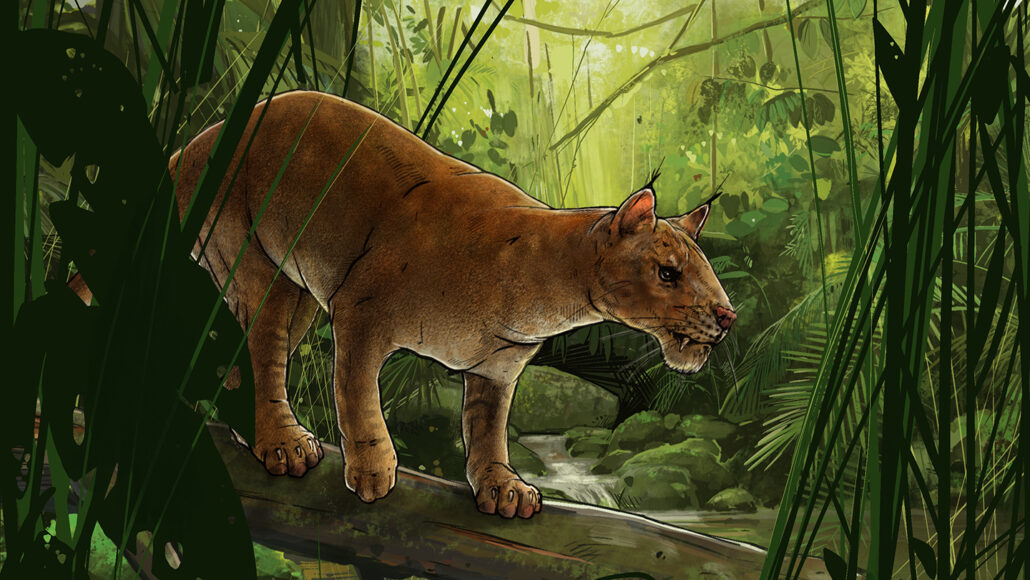One of the earliest meat-eating mammals was saber-toothed
It walked the planet millions of years before saber-toothed cats

Here is an artist’s idea of what the newly identified predator looked like. It sought its meaty meals some 42 million years ago.
San Diego Natural History Museum
Scientists have just identified a mysterious new species of extinct mammal. This fearsome bobcat-sized creature prowled the rainforests of what is now San Diego, Calif., some 42 million years ago. Unlike most other mammals of its time, it was built to eat meat and little else. Scientists describe such predators as hypercarnivores.
Meet Diegoaelurus vanvalkenburghae (Dee-AYE-go-leur-us Van-VAAL-ken-BERG-ee-aye). But don’t get caught up in its tongue-twister name. Focus on its jaws. This creature was among the first mammals to host saber-like fangs and sharp slicing teeth.
It belonged to a family known as Machaeroidine (Mak-ay-ROY-deen). Until now, only about a dozen other fossils from this family had been seen. Most turned up Wyoming. A few others had been found in Asia. Paleontologists were able to identify the new predator thanks to a 71-millimeter (2.8-inch) fossil of its lower jawbone — with teeth. It was unearthed in a San Diego County fossil bed. This fossil bed had actually first been discovered in the ‘80s, by a 12-year-old boy.

That jaw shows the creature had long, saber-like canines. The creature’s downturned, bony chin would have protected those fangs. These canines were never found. But a gap in the lower teeth shows they would have fit in, notes Ashley Poust. He’s a paleontologist at the San Diego Natural History Museum. He and his colleagues described their find March 15 in PeerJ.
The new jawbone has been part of the museum’s collection since 1988. It was originally found at a construction site over a fossil bed. New analyses of the animal’s jaw and teeth (some of which were serrated), now show it to be the first species in its family found on the U.S. West Coast.
“Those big fangs were either used to bite into the throat of the prey or were used to rip and tear the flesh,” Poust says. “This fossil, in particular,” he adds, “helps us understand what the whole food web would’ve looked like.” Poust imagines “there might have been this crazy saber-toothed animal stalking primates in the branches.” Or maybe, he says, the beast would have stalked tapirs in the leaves below.
Hypercarnivores still exist. Some are massive, such as polar bears. Others are deadly stealth stalkers, such as tigers. Still others may comfortably snuggle in your lap, like the housecat. But being a strict meat-eater was uncommon for predators in the Eocene Epoch, which ended some 34 million years ago.
That’s what makes the newfound species so interesting. It provides an early glimpse into how different families of animals independently evolved the ability to slice flesh with ease. Their daggerlike fangs have turned up in a wide range of animals. They include ancient anchovies and the much more recent saber-toothed cats such as Smilodon. That last predator wouldn’t make its first appearance until millions of years after D. vanvalkenburghae went extinct.







